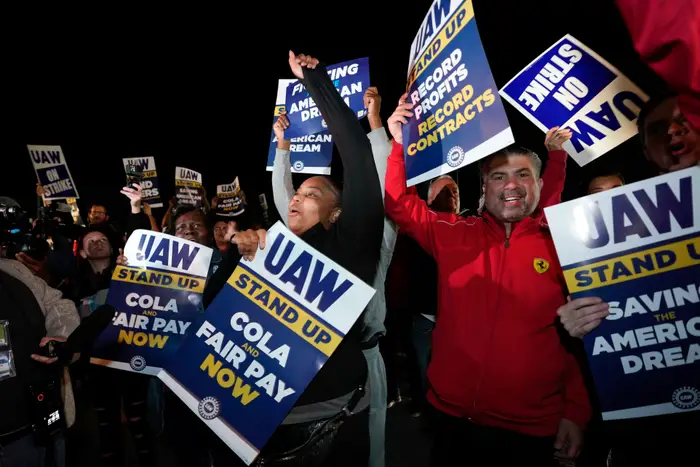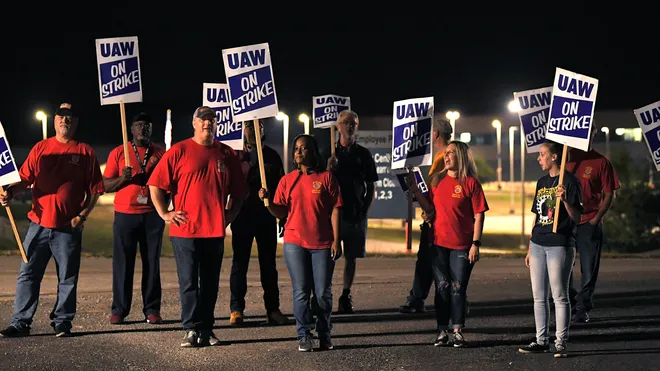Newsmatro

In a significant and unprecedented development, the United Auto Workers (UAW) initiated a major strike late Thursday by simultaneously targeting all three major Detroit automakers after contract talks failed to yield a new agreement.
As the clock struck 11:59 p.m., UAW members at assembly plants in Michigan, Ohio, and Missouri went on strike, kicking off what the union is calling the “Stand Up Strike.” This strike specifically takes aim at select plants of Ford Motor Co., General Motors (GM), and Stellantis, the manufacturer of Chrysler, Dodge, Jeep, and Fiat brands.
UAW leaders have outlined a strategy that involves selecting new target plants for strikes in waves if negotiations continue to falter. This approach is designed to keep the automakers on edge and bolster the union’s bargaining position to secure more favorable contract terms than those previously offered by the Detroit automakers.
The initial three facilities selected for the strike are Ford Michigan Assembly Plant (Final Assembly and Paint only) in Wayne, Michigan; Stellantis Toledo Assembly Complex in Ohio; and General Motors Wentzville Assembly in Missouri.
UAW President Shawn Fain, in a late-night livestream to union members on Facebook Live, stated, “This strategy will keep the companies guessing. It will give our national negotiators maximum leverage and flexibility in bargaining. And if we need to go all out, we will. Everything is on the table.”
Fain urged members to maintain organizing efforts, including rallies, protests, and red shirt days, emphasizing the need to demonstrate unity and readiness to take action.
The strike followed a day of intense last-minute negotiations between the UAW and the three automakers. Negotiations had been ongoing since late summer, with the UAW engaging with each carmaker separately but concurrently.
Automakers Express Disappointment
Shortly before midnight, GM issued a statement, announcing that the UAW had informed them of the strike at Wentzville Assembly as of 11:59 PM. GM expressed disappointment in the UAW’s actions, despite GM’s offer of what it described as an “unprecedented economic package,” which included substantial wage increases and manufacturing commitments.
Stellantis also expressed its disappointment in the UAW’s approach, characterizing it as irresponsible and contrary to reaching a fair agreement in the best interests of employees, their families, and customers.
Strategic Move to Spur Negotiations
The UAW’s initial choice of strike targets, one from each of the three automakers, is strategically significant. Labor expert Harley Shaiken, professor emeritus at the University of California, Berkeley, noted that this approach aims to create economic pressure on the automakers without causing a widespread company paralysis. Instead, it is meant to stimulate negotiations.
However, Shaiken pointed out that if this tactic does not lead to improved offers, the UAW may consider targeting more “strategic” plants that produce vital components, potentially escalating pressure on the automakers and causing disruptions at facilities reliant on these components.
Shaiken added, “What puts us in uncharted waters is a number of sharply different paths open to the union to press its demands. We also have to be aware, however, that the UAW isn’t the only actor here. The automakers could begin choosing strategic options as well.”
Marick Masters, a labor expert and business professor at Wayne State University, highlighted the significance of the UAW’s action, describing it as a move that conveys the union’s resolve to apply increasing pressure in pursuit of better contract terms.

Late-Night Bargaining and Counterproposals
Following Fain’s address at 10 p.m., Ford provided an update on its negotiations with the UAW. The automaker stated that the UAW had presented its first substantive counterproposal at 8 p.m. at Solidarity House in Detroit, just hours before the existing four-year collective bargaining agreement was set to expire.
Ford emphasized the generosity of its last offer, including substantial wage increases, cost-of-living adjustments, increased paid time off, additional retirement contributions, and more. However, the UAW’s counterproposal reportedly showed limited movement from the union’s initial demands, prompting Ford to announce that unless it accepted the UAW’s “unsustainable terms,” a strike would commence at 11:59 p.m.
GM CEO Mary Barra disclosed earlier in the day that GM had made a significant offer to the UAW, increasing the hourly wage increase to 20% over the contract’s lifespan, up from the previous 18%.
UAW’s Demands and Path Forward
UAW President Shawn Fain unveiled a list of member demands on August 1, including:
To secure a tentative agreement ratifiable by its membership, the UAW seeks an offer that goes further on critical issues such as wages, faster attainment of top-tier wages, and the utilization of temporary workers. Labor expert Marick Masters suggested that a settlement would likely require an increase in general wages exceeding 30%, expedited progress to top-tier wages, and restrictions on the use of temporary workers.
The UAW’s aim is to ensure workers receive a fair share of the automakers’ profits, which have been substantial in recent years, amounting to billions of dollars, while emphasizing that hourly workers deserve more equitable compensation.
As negotiations continue and the strike unfolds, both the UAW and the automakers will closely monitor developments in this high-stakes labor dispute.